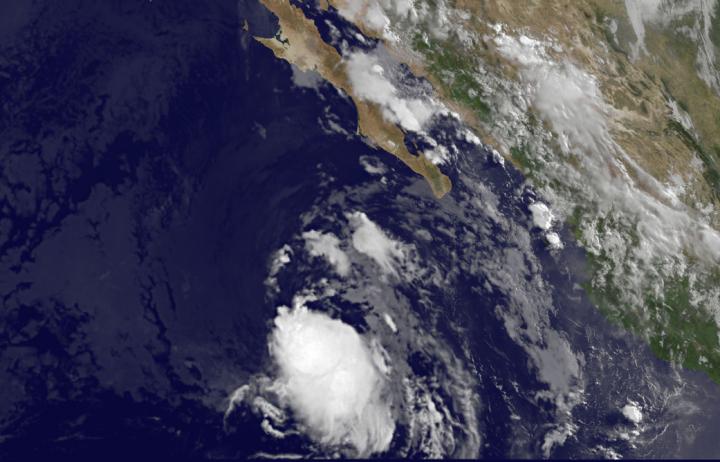Satellite sees birth of Tropical Storm Felicia in Eastern Pacific Ocean

NOAA's GOES-West satellite captured an image of Tropical Storm Felicia on July 23 at 11:45 a.m. EDT showing a curved band of thunderstorms are wrapping around the southern quadrant of the storm. Credits: NASA/NOAA GOES Project
Previously known as tropical low pressure area “System 99E,” the storm finally developed after days of remaining unorganized. NOAA's GOES-West satellite captured an image of Tropical Storm Felicia on July 23, 2015 at 15:45 UTC (11:45 a.m. EDT). Satellite imagery shows that a curved band of thunderstorms are wrapping around the southern quadrant of the storm.
The low pressure area became Tropical Depression 7E at 5 a.m. EDT (0900 UTC) on July 23. By 11 a.m. EDT (1500 UTC) the depression strengthened into a tropical storm and was named Felicia. At that time, Felicia was located near latitude 19.1 North, longitude 114.9 West.
Felicia was moving toward the northwest near 13 mph (20 kph) and is forecast to turn to the west-northwest is forecast by Friday night, July 24. Maximum sustained winds were near 40 mph (65 kph).
The National Hurricane Center's forecaster Brennan noted that Tropical Storm Felicia doesn't seem to have much of a chance to develop much more as it's heading into cooler waters and moderate northerly vertical wind shear is expected to continue until it gets into those cooler waters.
The area it is headed toward are 26 Celsius (78.8 Fahrenheit), and tropical cyclones need sea surface temperatures of at least 26.6 Celsius (80 Fahrenheit) to maintain or increase intensity.
The National Hurricane Center expects Felicia to weaken late on July 24 and become a remnant low pressure area over the weekend of July 25 and 26.
Media Contact
All latest news from the category: Earth Sciences
Earth Sciences (also referred to as Geosciences), which deals with basic issues surrounding our planet, plays a vital role in the area of energy and raw materials supply.
Earth Sciences comprises subjects such as geology, geography, geological informatics, paleontology, mineralogy, petrography, crystallography, geophysics, geodesy, glaciology, cartography, photogrammetry, meteorology and seismology, early-warning systems, earthquake research and polar research.
Newest articles

Superradiant atoms could push the boundaries of how precisely time can be measured
Superradiant atoms can help us measure time more precisely than ever. In a new study, researchers from the University of Copenhagen present a new method for measuring the time interval,…

Ion thermoelectric conversion devices for near room temperature
The electrode sheet of the thermoelectric device consists of ionic hydrogel, which is sandwiched between the electrodes to form, and the Prussian blue on the electrode undergoes a redox reaction…

Zap Energy achieves 37-million-degree temperatures in a compact device
New publication reports record electron temperatures for a small-scale, sheared-flow-stabilized Z-pinch fusion device. In the nine decades since humans first produced fusion reactions, only a few fusion technologies have demonstrated…





















